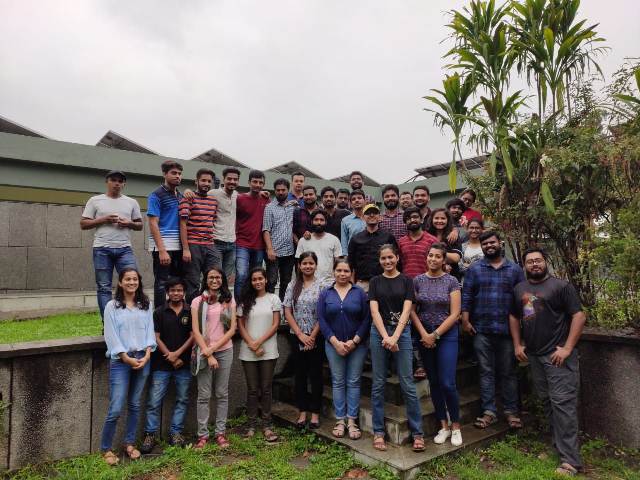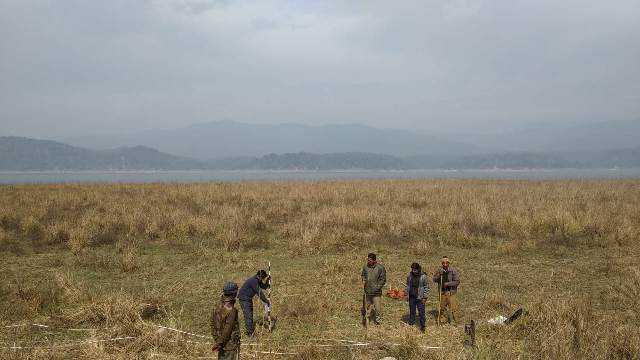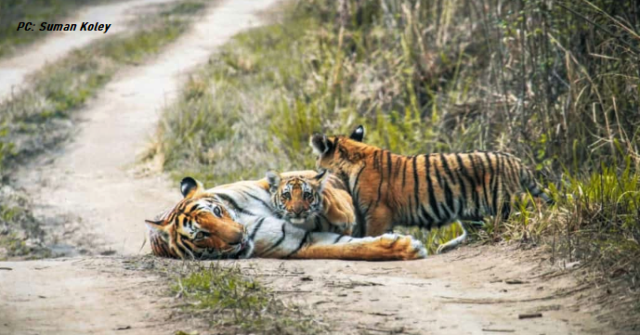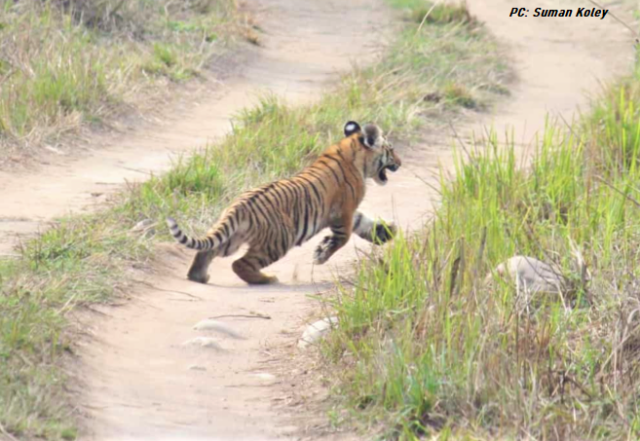Stripes Unleashed
-Prashant Mahajan
The start of 2019 was wonderful for me as I was recruited as a Research Biologist for the “All India Tiger Monitoring” project at the prestigious Wildlife Institute of India. After spending a few days at the institute I was sent to the most celebrated
tiger reserve of India the “Corbett Tiger Reserve” to carry out the field work along with the researchers already present there. I reached the base camp on 15th February, 2019 which was to be my home for the next three months. The next day I went inside the
tiger reserve to deploy camera traps for capturing images of tigers and other species.

I was very excited that I will be working inside the core zone of the tiger reserve and more than that I was hoping that finally I will be able to see the tigers. Before this field, I had been to tiger reserves three times, first in 2014 when I was in
my Bachelor’s at DU, we went to the Bandhavgarh Tiger Reserve, which was my first ever experience into the amazing wilderness of India. I enjoyed the safari but wasn’t able to see any tiger and we only came across some pug marks. Then for my Master’s dissertation
I went to the northern periphery of the Corbett Tiger Reserve, where I used to go to the kill sites of tigers and leopards. I encountered indirect signs and kills made by tigers around the villages, but not a tiger since I was working only in the periphery
area of the reserve.Then, in 2018 when I was working on wolves in the Kailadevi Wildlife Sanctuary which is a part of the Ranthambore Tiger Reserve and has only 4-5 tigers,I never got a chance to go for the Ranthambore National Park safari, which has a high
probability of sighting tiger. After all these visits to national parks and sanctuaries, I really wished to see a tiger in the wild even more.

Our daily routine field work was to walk transect line in the early morning and to deploy camera traps after calibration which usually takes 1-2 hours. During the first day of field visit our driver, Sonu assured me that he would make sure that I sight
a tiger in the second or third day of field. According to him all the researchers who had visited so far were able to sight at least one tiger within 2-3 days of their visits. Two days had already passed and I hadn’t been able to spot any tiger even though
we were working in the highly tiger dense area. Then on the third day after retrieving our earlier deployed camera traps from the Dhikala zone, we were exploring different areas of the zone to retrieve our cameras. I was very hopeful that I’d be able to see
a tiger since I was working in the best zone, where the chances of sighting tiger are quite high. After finishing our work, I was disappointed that I still couldn’t spot a tiger, and it was already evening time. We were returning and all of us were very tired
and sleepy. Half way across suddenly Sonu screamed, “Tiger! Tiger! Tiger!” We all became conscious and started looking for the tiger here and there, and then, I saw a huge male tiger standing just 20 meters away from our jeep. He was such a huge young tiger
with a bright orange coat, looking mesmerizing in the green lust forest of Corbett. He was coming downhill and our sudden entry had startled him, and due to that fear he roared loudly and aggressively, charging towards us. We were sitting in our jeep, terrified
and wondering what if he came at us. Sonu was well experienced and knowledgeable and knew how to handle these kinds of situations. He started the engine and first he reversed the jeep, stopped there at some distance. By that time the tiger had also started
moving in different directions. From the road ahead, forest guards were coming and after seeing them, the tiger disappeared into the valley. This was the very first experience of mine- sighting a tiger in the wild and that too so thrilling and unforgettable
causing a high adrenaline rush, excitement and fear at the same time. This was my first sighting and the sighting which will last forever in my mind, not because it was the first but also because of the series of events that took place. Then after that I
saw tigers many times during my three-month field work.

I would love to narrate, the one sighting which is indeed worth sharing. After retrieving our cameras from the Dhikala zone, when we were heading back, we started hearing alarm calls from the langurs and chitals. We checked around but didn’t spot any tiger.
Suddenly, we saw a fresh kill of chital inside the lantana bushes. We stopped by and started looking here and there for tiger presence, and then in the most unexpected manner, we saw a tiger emerging out of the bushes .She was “Paarwali”, the famous tigress
of the Dhikala zone. Then while we were observing her from the distance, we saw one of her little cubs crossing the road; a second cub followed, and finally a third. He looked around here and there, went back inside the bushes, then again emerged and crossed
the road after a few minutes. While we were waiting to see the tiger and her cubs, we saw that the cubs hurriedly went from one patch of the forest to the other patch, and their mother Paarwali was just looking towards the patch where her cubs went. Then she
started calling her cubs by making the long “Humm” sound continuously. We were there waiting for the cubs to come out. Meanwhile, Paarwali lay down and we saw the cubs approaching towards her. She put her arms around the cubs and started licking and playing
with them. It was such a wonderful and sweet moment and I feel lucky to have witnessed such a sight, and to observe tiger behavior in their natural habitat. Till date it was my best tiger sighting out of many.

During the three month field work in the Corbett Tiger Reserve, it was not only tiger that I came across, but many different species of birds, ungulates and elephants in large numbers. We saw large herds of elephants in the grasslands, sometimes as many
as 500 and more. We encountered elephants frequently while walking transects. One time when I was going inside the forest with our driver Sanjay ji, we came across a sharp turn on the dirt road and we suddenly saw a huge male elephant approaching us. It was
such a horrifying moment and for few seconds we were frozen and didn’t know what to do. Then, Sanjay ji hurriedly started the jeep and we somehow escaped through the situation. Although the elephant was not in a mood to chase, but nonetheless, encountering
an elephant from nowhere can make your heart beat fast.
Certainly, my three months of field work at the Corbett Tiger Reserve were worth remembering and to cherish for many years to come. After completing the field work in May, 2018, we went back to our headquarters in Dehradun, where we were engaged in data
analysis and sorting of the large number of images collected from all over India.
I feel proud and happy to have been a part of such a mammoth exercise. Recently, the All India Tiger Estimation project received the Guinness World Record for conducting the largest camera trap survey in the word. There were 26,838 locations where camera
traps were placed, 121,337 sq. km. of area was effectively surveyed and 76,651 photos of tigers were captured during the whole exercise. Working with the Tiger cell at Wildlife Institute of India was one of my best experiences and I got a lot of opportunities
to learn and grow. I made some really good friends and will always remember and cherish those beautiful moments.

( Prashant Mahajan is a a graduate in B.Sc. Zoology (H) from the University of Delhi and having a master's degree in Wildlife Sciences from Aligarh Muslim University (2018). He is currently working as a Project Fellow at Wildlife Institute of India in
the project "Population management of species involved in Human-wildlife conflict"). He can be contacted at Prashant_mahajan@rocketmail.com or at +91-9997999970. He also has a blog at Lifeofawild.wordpress.com.)